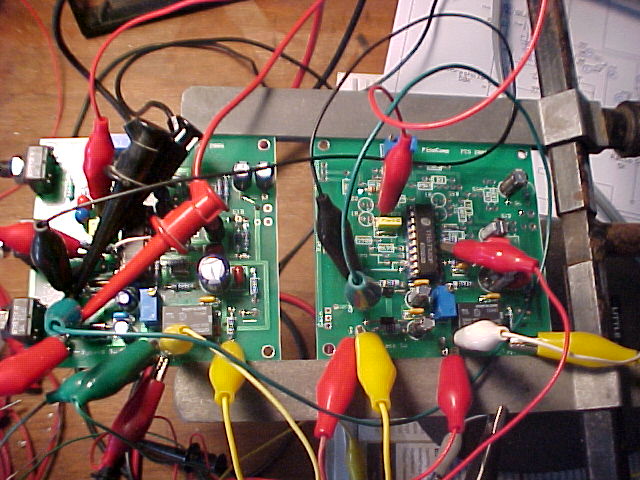The Pico Compressor Stereo Edition will be using a detection method called "True Power Summing." I thought it would be a good idea to re-visit the subject as it is one of the key design elements of the Stereo Pico Compressor and is a build option for Original Pico Compressors in linked-dual-mono.
The Blackmer (tm) RMS detector, used in the THAT4301, THAT2252, and most dBx products provides a measure of signal power. When a stereo compressor using individual rms detectors in the left and right channels have their rms outputs combined at the timing capacitor, the powers sum. Remember that a doubling of power is a 3 dB increase.
In an experiment I ran recently I combined the detector outputs of the Pico Compressor. Each, with 1V (rms) audio in, produced 1VDC out (after trimming them to match). Combined their outputs were ~1.019 VDC. The output scaling of the THAT4301 is ~6.6 mV/dB. Thus the combined detector output produces an ~19.8 mV increase representing a "true" 3 dB power sum.
We discuss this again in Keith's Ultimate GSSL post. In Keith's Post we learn that his Ultimate GSSL is more similar to the orignal SSL Mix Compressor in that it detects whichever channel has "the greater of two" peaks. (And I might add that his differential VCA connection is brilliant.)
Edit 11/07: I also wrote this article published here in the Pico Compressor Forum:
http://www.ka-electronics.com/forum/php ... p?f=6&t=17
The original GSSL Clone posted here in this forum uses an algebraic sum where the left and right inputs are combined as audio prior to detection. This can also be called L+R detection. It is an option available to the Pico Compressor builder as well. L+R detection is computationally biased to detecting, and thus more heavily compressing, mono. If two identical inputs are fed into an L+R detector, but one of the inputs has its' polarity reversed, the detectors output will be zero because the sum of the audio input is zero. Thus, more highly correlated signals will receive the most compression, while completely uncorrelated material will receive no compression. Put simply, mixes get wider.
Keith's Ultimate GSSL and the Pico Compressor combine detector outputs. Because of this, both the Ultimate GSSL and the Pico Compressor are insensitive to phase, polarity, or correlation because summation occurs after detection. In my previously cited experiment I had great fun flipping signal polarity and seeing no combined detector output change.
So what are the differences between true power summing and "greater of two" peak detection? I'm willing to go out on a limb here and make a broad generalization: Peak response is very desireable when the signal has to fit the confines of a transmission channel or storage medium. It provides fast response. RMS detection more closely emulates perceived loudness and is thus more suitable to increase program density. Think 1176 vs. LA-3. The Stereo Edition of the Pico Compressor will have multiple "peak" and rms timings.
Both peak detection and rms have their place. "Greater of two" peak response, or true power summed rms, will both image more accurately than an L+R or algebraic sum will because they are phase and polarity insensitive.
I'd played around with discrete rms detectors many years ago and remembered that the outputs could be combined with one another. After I proposed combining the detector outputs of the 4301 for the Pico Compressor and confirming that it was possible, I discovered that it had a name: True Power Summing. See THAT's application notes on the subject DN-116 (page 4) and DN-118 (page 2).
So after I received my Pico Compressor Boards I built one:

And it sounded incredibly smooth! So I decided to record a demo cut with all controls set to maximum compression to see how it would image. (Threshold Min, Ratio Max, Makeup Max. Hammered real hard.)
Listen for yourself: https://www.ka-electronics.com/Content/stereodemo.mp3
Vocal stays out front eh? Close your eyes and it paints a picture. Now it is squashed I'll admit. But things don't move. As you can see there's lot's of wires though even though the true power sum portion is nothing more than a short between timing caps. (The slave channel is on the right.) Since my entry wouldn't win any beauty contests Roger built his. Checkout those Blue LEDs.
And he built it with True Power Summing as well. Now each of us had to do a lot of extra work (OK Roger had to do a lot of extra work) to enable the switching between dual mono, stereo etc. It added a lot of time to the build. And he listened a lot. I think that's when he decided it might be good idea to build a dedicated stereo compressor that used true power summing.
So who else has done this? Well THAT knows about it and it goes as far back in dBx as the 160. But strapping a pair of 160s together is something I almost never saw. We've also seen references to it in the 165, 166 and the dBx Quantum whose rms calculation is done in DSP. We find these in various dBx manuals:



And also this:
http://www.stellacustomelectronics.com/c1.html
A mastering compressor? Cool.
Edit 11/07: Apparently Stella Custom Electronics has ceased production.
The Pico Compressor Stereo Edition will not only have True Power Summing but, like the Original Pico Compressor will have a switchable Peak Mode along with a new adaptive Auto mode using the "non-linear capacitor" as featured in THAT's DN-114.
Stay tuned...